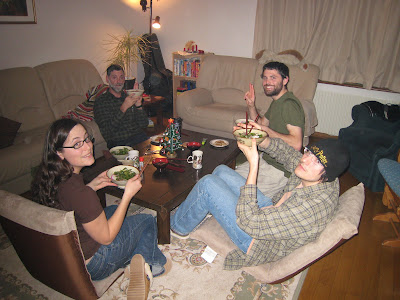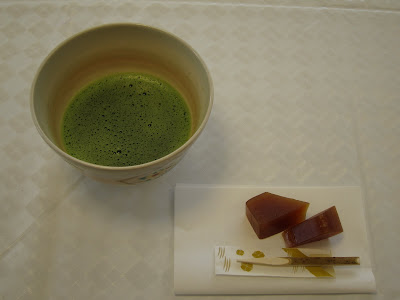But I digress. I'm supposed to be writing about Japanese New Year (お正月=oshougatsu), which is celebrated on January 1 along with the western world. The Chinese New Year party merely served to remind me that I am behind on my posting, so I need to get my act together.
My parents and brother came to Sapporo on December 28 to celebrate New Year's and generally have some family time. Thus I decided to explore as fully as possible the interesting Oshougatsu traditions and foods so we could all enjoy them together. In Japan, as in many other places in Asia, the New Year celebration is an important time for the extended family to gather together for feasting and fun. It isn't a wild party like it is in the US. In Japan, that's what Christmas is for. I am not making this up. ;)
On New Year's Eve, I spent most of the day preparing おせち (osechi), the traditional box of food which is eaten over the first three days of the new year. The idea is that the women of the house will then be able to rest from cooking. Whether or not it actually saves any time is another story... Most Japanese women who prepare osechi begin to prepare it several days in advance. On retrospect, this would have been a wiser choice. I cannot tell you how much my back hurt when I was finally finished... and I had a lot of help from Mom and Colin. By the way, when I explained to Japanese friends that I intended to prepare osechi, I was met with shocked looks: it's practically unheard of for a foreigner to do this. They were really excited to give me advice, though.
Consulting the cookbook... all in Japanese, but thankfully, there are lots of pictures.
All 3 burners going all day. It got pretty warm in the kitchen. Incidentally, I highly recommend cooking chopsticks and the otoshibuta method (that would be the parchment paper covered pot in the foreground).
For dinner that night, we had traditional New Year's soba noodle soup, the significance of the noodles being long noodles for long life. We also had gyoza, since that's what we eat for Chinese New Year, and I like making gyoza with Colin. It just seemed fitting.
Gathered around the table for New Year's Soba
After dinner, we went upstairs to our neighbor's part of the house for our gaijin party, which ended up not being very wild. (Gaijin is the Japanese word for foreigner, by the way. In this case, the party-goers were my family and other OMF missionaries.) I was surprised that my family managed to stay up until midnight, including Dad, who "turns into a pumpkin at 11 p.m." It took me weeks to get to that point after we arrived in Japan.
On New Year's morning, we put the finishing touches on our New Year's card. Japanese people do not send Christmas cards. They send New Year's cards. Technically, we should have sent cards before Christmas, but with the Christmas concerts and all, there really wasn't time, so we opted for sending ours by email. Oddly enough, all the specially marked postcards mailed between December 15 and 25 anywhere in Japan are delivered the morning of January 1. People get really creative with these cards.
After breakfast, which was natto over brown rice (which, oddly enough, my whole family loved)...
Really, they loved it!
...we went to church for a new year's service at Kibou no Oka church, where Keith teaches English, and where my January 3 concert was held. Going to church is not a typical Oshougatsu activity, as only 1 percent of the Japanese population is Christian.
Posing in front of the church sign board, where my concert poster is displayed.
After the service, we participated in tea ceremony (お茶=ocha) and mochi pounding (餅つき=mochitsuki). Mochitsuki is a family activity which takes place around the new year. Like osechi, it is designed to "provide rest" to the women of the house, since no rice needs to be prepared during the three days of the Oshougatsu period. Cooked sticky rice is placed into a special wooden stand-bowl (see picture--I really don't know how to describe it) and then pounded to a paste with a huge wood hammer. Often this is done by a husband and wife--the husband operates the hammer while the wife kneads the dough and adds water between strokes.
Matcha with a red bean sweet
Even the kids drank matcha. I was surprised, because matcha is known for being bitter and not at all kid-friendly. The blond kid (Jonathan) drank it straight down, but the other two weren't so sure about it.
Colin helped out with mochitsuki. The kids provided moral support, and Watanabe-san, who is in charge of Keith's English classes and my concert, kneaded the dough between strokes.
What to do with mochi: use it like dumplings in ozouni soup...
...or make daifuku--sweet red bean filled mochi balls. Yum!
Our next stop was the Hokkaido Shrine, which is located at the edge of Sapporo in a beautiful park. Most Japanese visit a shrine to offer prayers for the new year during the holiday period between January 1-3. This is called 初もうで (hatsumoude). I'm certainly no expert on Shinto religious practices, so I'll just make a few observations.
The shrine, as expected, was mobbed with people. However, also as expected, Japanese crowd control being the fine art that it is, everyone waited patiently for their turn to enter the shrine.
Sign reads: "Please wait a little while." Everyone kindly obliged.
Once we were inside, we observed visitors buying fortune slips and amulets for protection and good fortune. People were praying in various ways: some wrote their wishes on small plaques and hung them on racks around special trees. Others threw their money offerings onto a big tarp laid out for that purpose as they said their prayers. Still others rang a bell or clapped their hands. According to our Japanese teacher, this is to alert the gods that you are about to start praying. We were also praying to the One True God on behalf of those gathered to worship other gods.
Wishes for the new year
Offering prayers and money
The courtyard of the shrine
On our way out, we were sorely tempted by all the delicious smelling food booths... but we already had a feast waiting at home!
When we got home, it was time to put the finishing touches on our osechi feast, which we then ate!! Hooray!
Arranging everything in pretty bento boxes. The ones for osechi have a specific name, but I can't remember what it is.
All done! Note pajama pants and tired expression.
The bento boxes pose with the advent wreath for a culture shock moment.
Here's the menu. Most of the recipes came from my Japanese language osechi cookbook, which I managed thanks to the convenient pictures for each step of each recipe. There are a few recipes in English from my favorite Japanese cooking website, so I've linked to those.
Box 1:
煮物 (nimono=stewed vegetables): carrots, taro root, lotus root, peas, konnyaku (not exactly a vegetable)
昆布巻き (kombumaki=stewed kelp rolls)
Box 2:
餃子(gyouza--not exactly traditional)
鮭 (shake=salmon--sort of hidden underneath the shrimp)
えびぎんなん (ebiginnan=shrimp and ginkgo nut skewers, except I substituted edamame for the ginkgo nuts)
Box 3:
Chinese Tea eggs (again, not very traditional)
きんぴらごぼう (kinpiragobou=gobou/burdock root and carrot stir fry)
かまぼこ (kamaboko=pink and white fish cakes)
黒豆 (kuromame=sweet black beans)
栗きんとん (kurikinton=mashed sweet potatoes with chestnuts)
Box 4: Mom's fun box of leftover bits that wouldn't fit in the other boxes. I did all the other boxes.
Box 5:
お赤飯 (osekihan=festive red beans and rice)
Okay, I'm finally finished! This post has taken hours... If you're not bored of oshougatsu yet, you can read my mom's take on it on her blog. I feel like I should end this post with "happy new year," but I won't, since it's a bit late for that. Happy almost spring? ;)































No comments:
Post a Comment